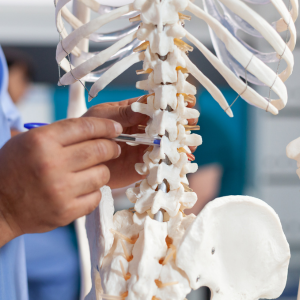Chronic pain conditions caused by medical conditions such as cancer, chronic reflex sympathetic dystrophy or complex regional pain sydrome and failed back syndrome impact your life to the point where maintaining function becomes difficult. Traditional pain relief methods – surgical, psychological, physical or pharmacological – have not helped to reduce the level of pain you have been living with.
What is Spinal Cord Stimulation and How Does it Work?
If you are an appropriate candidate, you undergo surgical implantation of a power source. A lead is attached by way of an extension wire. Depending on the complexity of the chronic pain, four to eight leads can be attached to extension wires and the power source, which is usually a battery or a radiofrequency receiver. Chronic pain conditions usually require more complex stimulation.
Spinal cord stimulation is used for pain conditions, and can also be used for treating critical limb ischemia and refractory chest pain. Medical professionals do not yet understand the neurophysiology of pain relief after you have begun using spinal cord stimulation. Two theories say that the pain relief may come from “activation of an inhibitory system” or through blockage of facilitative circuits or nerves that transmit and facilitate the chronic pain, states the Blue Cross Blue Shield of Montana website.
When you are undergoing testing to determine if you are a suitable candidate for spinal cord stimulation, your pattern of pain distribution is closely studied as your doctor decides where the stimulation lead should be placed. Once you have been found to be a suitable candidate for this type of pain therapy, you undergo two surgical procedures. The first is the implantation of an electrode into the epidural space. At this point, you go through a trial period of spinal cord stimulation to determine whether treatment will be effective. For this type of therapy to be considered effective, you must experience at least a 50 percent reduction in pain. Once this has been determined, you then go through the second stage of surgery, which involves permanent implantation of the electrodes and the radio-receiver/transducer.
 This type of therapy is considered a “therapy of last resort,” used only after other treatment methods have failed or if those methods are contraindicated for any reason. For you to be considered an appropriate candidate for spinal cord stimulation, your pain must be neuropathic. That is, you have suffered physical damage to the peripheral nerves in your body. Some of thes e types of pain can include phantom pain or stump pain, radiculopathies or peripheral neuropathy. The types of pain this therapy will not affect include nerve irritation or nociceptive pain and pain that is related to a central nervous system damage that is the result of a spinal cord injury or stroke.
This type of therapy is considered a “therapy of last resort,” used only after other treatment methods have failed or if those methods are contraindicated for any reason. For you to be considered an appropriate candidate for spinal cord stimulation, your pain must be neuropathic. That is, you have suffered physical damage to the peripheral nerves in your body. Some of thes e types of pain can include phantom pain or stump pain, radiculopathies or peripheral neuropathy. The types of pain this therapy will not affect include nerve irritation or nociceptive pain and pain that is related to a central nervous system damage that is the result of a spinal cord injury or stroke.
Study Results
A pain relief study using spinal cord stimulation was conducted at the Maastricht University Hospital in Maastricht, the Netherlands. Dr. Marius A. Kemler, et al., conducted the study with patients between the ages of 18 and 65 years of age. These patients all met the diagnostic criteria for reflex sympathetic dystrophy as established by the International Association for the Study of Pain. Each patient suffered from impaired function and symptoms ranged beyond the area of injury. Other requirements for enrollment in the study included disease and pain clinically restricted to one foot or hand. The pain lasted for at least six months and did not respond well to standard therapy, to include six months of physical therapy, transcutaneous electrical nerve stimulation, sympathetic blockade or pain medications, according to Kemler, et al.
Conditions that excluded patients from the study included a current or previous neurologic abnormality that was unrelated to the sympathetic dystrophy, Raynaud’s disease, a blood-clotting disorder or use of anticoagulant medication, a condition affecting the function of the diseased extremity or the use of a cardiac pacemaker.
Each patient responded to a 90-item symptom checklist measuring levels of psychological distress. Scores nearing or reaching 450 showed the patient was in severe psychological distress, with those scoring 200 or higher undergoing a full psychological examination meant to rule out a major psychiatric disorder or substance abuse, as well as to look at any issues of a possible secondary gain from the treatment of an illness.
Patients who were selected underwent a test to determine if they would have a positive response to spinal cord stimulation. For those who had no response, no implant was scheduled. The patients selected for implantation underwent a prophylactic, intravenous dose of an antibiotic, then placed into a prone position. Using direct fluoroscopy, the epidural space of the spinal cord was entered using a Tuohy needle. Depending on the limb affected, a temporary electrode was passed through the needle and implanted at the appropriate level for the limb. Generally, this meant the C4 epidural space was used for the electrode if the hand was involved. If the foot was involved, the T12 epidural space was used. An external stimulator was connected to the electrode, then positioned so the patient could stimulate the electrode. Ideally, the patient would report pain relief over the entire area where he experienced his pain. When implantation was successful, the needle was removed and the elect rode was stitched to the patient’s skin, then connected to the stimulator. The patient was required to undergo a seven-day home-testing process while going through their normal daily activities. After the seven-day trial period, surgeons removed the temporary lead. If the patient indicated a score of “at least” 6, indicating a “much improved” status on a seven-point scale, he underwent implantation of the spinal cord stimulator. In addition to spinal cord stimulation, each patient was also required to undergo standardized physical therapy twice per week for six months.
Blue Cross Blue Shield of Montana also reported that an evidence-based review was done by the American Society of Pain Physicians and they found that evidence was strong for short term pain relief and moderate for long term pain releif in relation to complex regional pain syndrome or reflex sympathetic dystrophy.
Blue Cross Blue Shield of Montana: Spinal Cord Stimulation; The New England Journal of Medicine: Spinal Cord Stimulation in Patients with Chronic Reflex Sympathetic Dystrophy.
